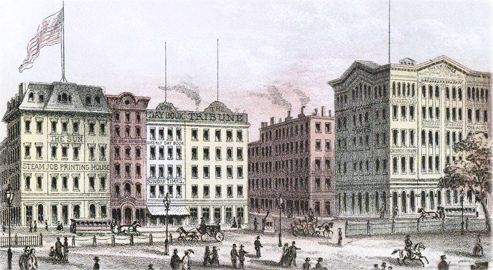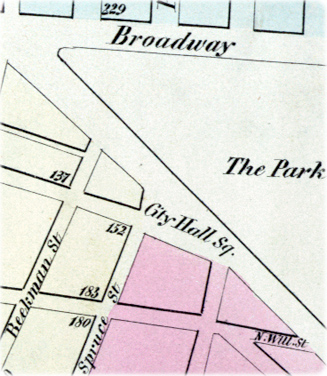
Printing House Square
The Printing House Square of Manhattan (there was a Printing House Square in London) is a small triangular square located opposite City Hall Park, at the intersection of Park Row and the Brooklyn Bridge approach, junction of Spruce Street and Nassau Street, now called Pace Plaza, after Pace University.
The New-York Gazette, issued November 8, 1725 by William Bradford, was the first New York newspaper, with only two pages, printed on a single sheet and published weekly. The second was The New-York Weekly Journal, issued by John Peter Zenger, beginning November 5, 1733. In the 18th century, some publishers moved to Hanover Square, in Lower Manhattan, including the New-York Gazette, The New York Mercury (1757) and Rivington’s Royal Gazette. Hanover Square was also known as "Printing House Square", but, in 1835, the Great Fire of New York destroyed much of Lower Manhattan.
In 1798, the Society of St. Tammany moved to a building at Nassau Street and Spruce Street (later, the site of Tribune). In 1812, they moved to the "Tammany Hall", a five-story building, at the corner of Nassau and Frankfort Streets. Tammany Hall became the Democratic Party's meeting place in New York City.
Still in 1812, the City Hall moved from the old Federal Hall, on Wall Street, to the new building in City Hall Park. Then, several publishers came to the area, specially to Nassau Street.
By 1830, the Press of New York City consisted of less than fifty journals, chief among them being the Commercial Advertiser, Evening Post, Morning Courier, New York Enquirer, Journal of Commerce, Standard, Porter's Spirit of the Times, Morris & Willis's Mirror, and the Knickerbocker Magazine.
On November 28, 1848, the open space fronting the Park, from Tryon Row to Ann street, was officially designated City Hall Square by the Common Council. In practice, the name was restricted to the area formed by the junction of Park Row, Nassau and Spruce streets, as shown in a map by William Perris, in 1852 (fragment on the right).
The name Printing House Square only made sense after the New York Times moved to its new Times Building in May 1858, on the site that was previously occupied by facilities of the Brick Church. In fact, the name "Printing-House Square" was christened by common consent before March 1859, as reported in the Frank Leslie's Illustrated Newspaper.
Among the publishers in or around Printing House Square were The World (founded in 1860), Baker & Godwin, New York Times, Tribune, Sunday Times, American Tract Society, New York Herald (founded in 1835), O Novo Mundo (1870, in Portuguese), Evening Mail, Scientific American (37 Park Row), The Independent (251 Broadway, corner of Murray Street), the Banker's Magazine, New York Observer, N.Y. Freeman's Journal, Daily Witness (1871-1879), The Day Book, Currier & Ives, The Sun (founded in 1833) and many others. By 1865, 54 newspapers were being published in the City of New York.
In the 1860s, printing and publishing was the third largest manufacturing industry in the City (garment manufacturing was the first and sugar was the second). Only in the 1970s, publishing passed garment manufacturing to become New York’s largest manufacturing industry.
In 1867, the Tammany Hall building, at Printing House Square, was sold to The Sun. In the same year, the name "Printing House Square" appeared in the Map of New York City by Matthew Drips.
The sculpture of Benjamin Franklin, by the German sculptor Ernst Plassman (1823–1877), was unveiled on January 17, 1872.
In 1875, the new Tribune Building was completed, starting a skyscraper competition in the area. In the late 19th century and early 20th century some publishers have moved from the area, including The Sun and New York Times.
By the early 20th century, the subway and the widespread use of the telegraph and telephone, changed the publishing industry's need to be closer to the post office and government institutions. In 1895, for example, the New York Herald moved to a new building at the junction of Broadway and 6th Avenue. In 1905, the New York Times moved to Times Square. In 1916, The Sun moved to Herald Square, merged with the Herald.
Later, in the 20th century, Pace College (now Pace University) took over the Tribune and NY Times buildings at the Printing House Square, which was renamed Pace Plaza.
More: Park Row in 19th Century ►
The Printing House Square in 1868, from the Manual of the Corporation of the City of New York by J. Shannon.

Fragment of a map by William Perris, 1852 (source NYPL). The place, that later became the Printing House Square, was indicated as "City Hall Sq."
Brick Church
|
Copyright © Geographic Guide - Antique images of NYC. |
Printing House Square
